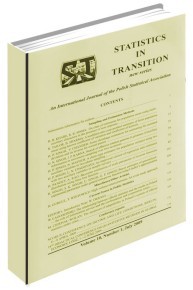ESTIMATION OF ENERGY INTENSITY IN INDIAN IRON AND STEEL SECTOR: A PANEL DATA ANALYSIS
ESTIMATION OF ENERGY INTENSITY IN INDIAN IRON AND STEEL SECTOR: A PANEL DATA ANALYSIS
Author(s): Anukriti Sharma, Hiranmoy Roy, Narendra Nath DaleiSubject(s): Energy and Environmental Studies
Published by: Główny Urząd Statystyczny
Keywords: energy intensity; Indian Iron and Steel sector; Energy Conservation Act; Perform-Achieve-Trade Mechanism; panel data.
Summary/Abstract: India is the world’s third largest consumer of primary energy, which includes fossil fuels like coal, oil, etc. The total primary energy consumption in India in 2015 was 107 Mtoe. India’s total final energy consumption was estimated at 527 Mtoe of which the industrial sectors consumed about 30% (185 Mtoe) in 2013. The Iron and Steel sector is one of the most energy-intensive industries, consuming about 25% of the total industrial energy consumption. The energy consumption in Indian Iron and Steel sector is on the declining trend. It declined from 10 GCal/tcs in 1990 to 6.9 GCal/tcs in 2010–11. On average, iron & steel plants spend about 20-40% of the total manufacturing cost to meet their energy demands. In fact, energy cost is considered as a major factor in pricing of the steel. Energy Conservation Act, 2001 (ECA), and the formulation of Bureau of Energy Efficiency are important initiatives taken up by government in order to reduce energy consumption by various sectors in the Indian economy. Another important initiative is launching of first of its kind market-based mechanism, Perform, Achieve and Trade (PAT) mechanism in 2010 particularly targeting the energy consumption by the industrial sector of the economy. Phase-I for PAT ran from 2012–015 including eight most energy-intensive sectors under Indian Industrial sector, with Iron and Steel sector being a prominent sector. The objective of this paper is to empirically estimate the energy intensity of Indian Iron and Steel sector, also accounting for the impact of ECA and PAT Phase-I in dummy variable form. The results indicate that the decline in energy consumption in this sector until 2011 can also be attributed to Energy Conservation Act implemented in the year 2001 along with other factors. This is empirically confirmed by our results that ECA has a significant impact on reduction of energy intensity of the steel firms. PAT does not seem to have a considerable impact on energy intensity alone but in the years where both PAT and ECA are prevalent, i.e. from 2012 to 2015, there seems to be a significant impact of around 0.050 reduction in energy intensity, as accounted by different models in this paper. There is one more observation from the empirical results that profit margin intensity was found to be negatively related to energy intensity implying more profitable firms invest more in energy efficiency.
Journal: Statistics in Transition. New Series
- Issue Year: 20/2019
- Issue No: 2
- Page Range: 107-121
- Page Count: 15
- Language: English

